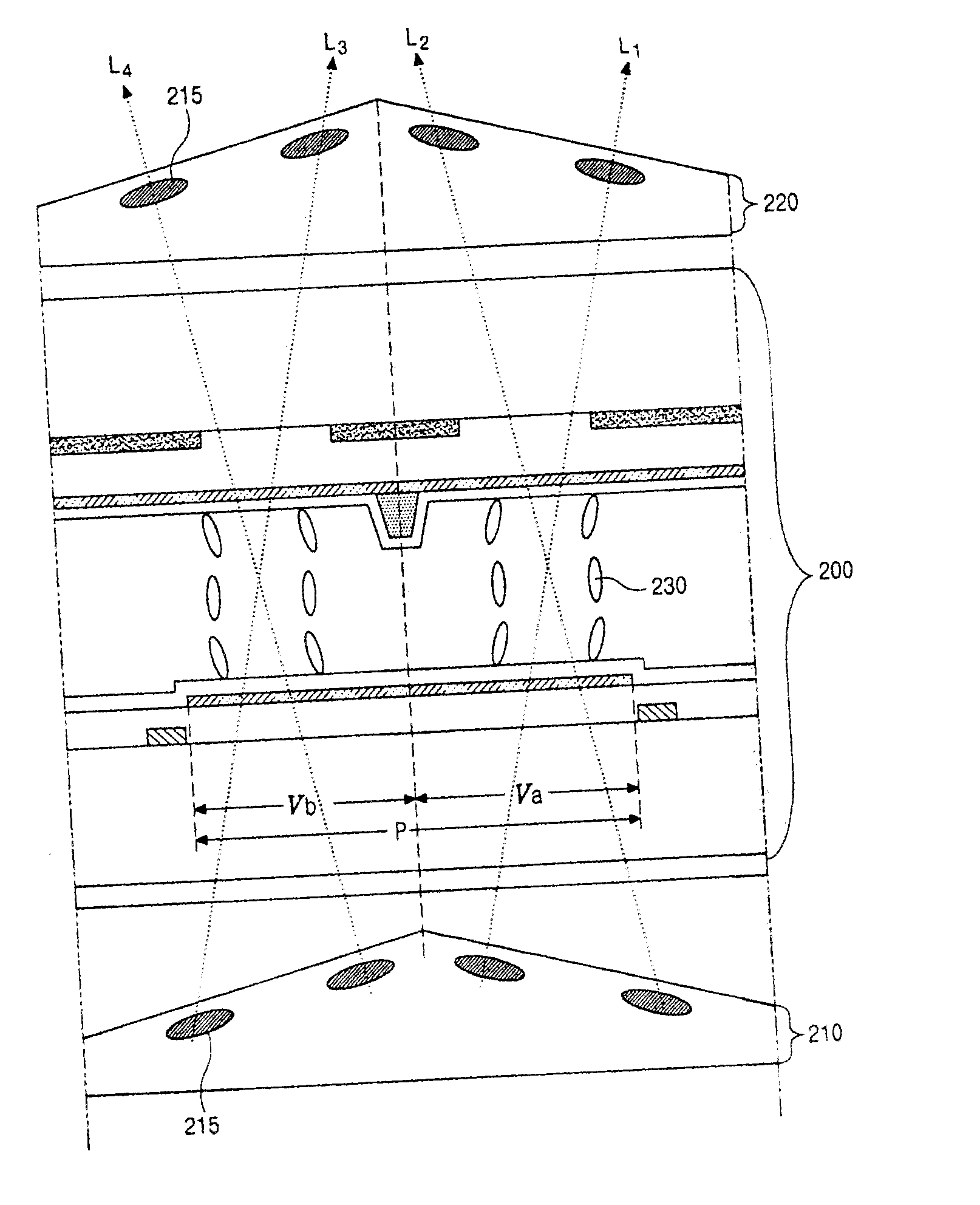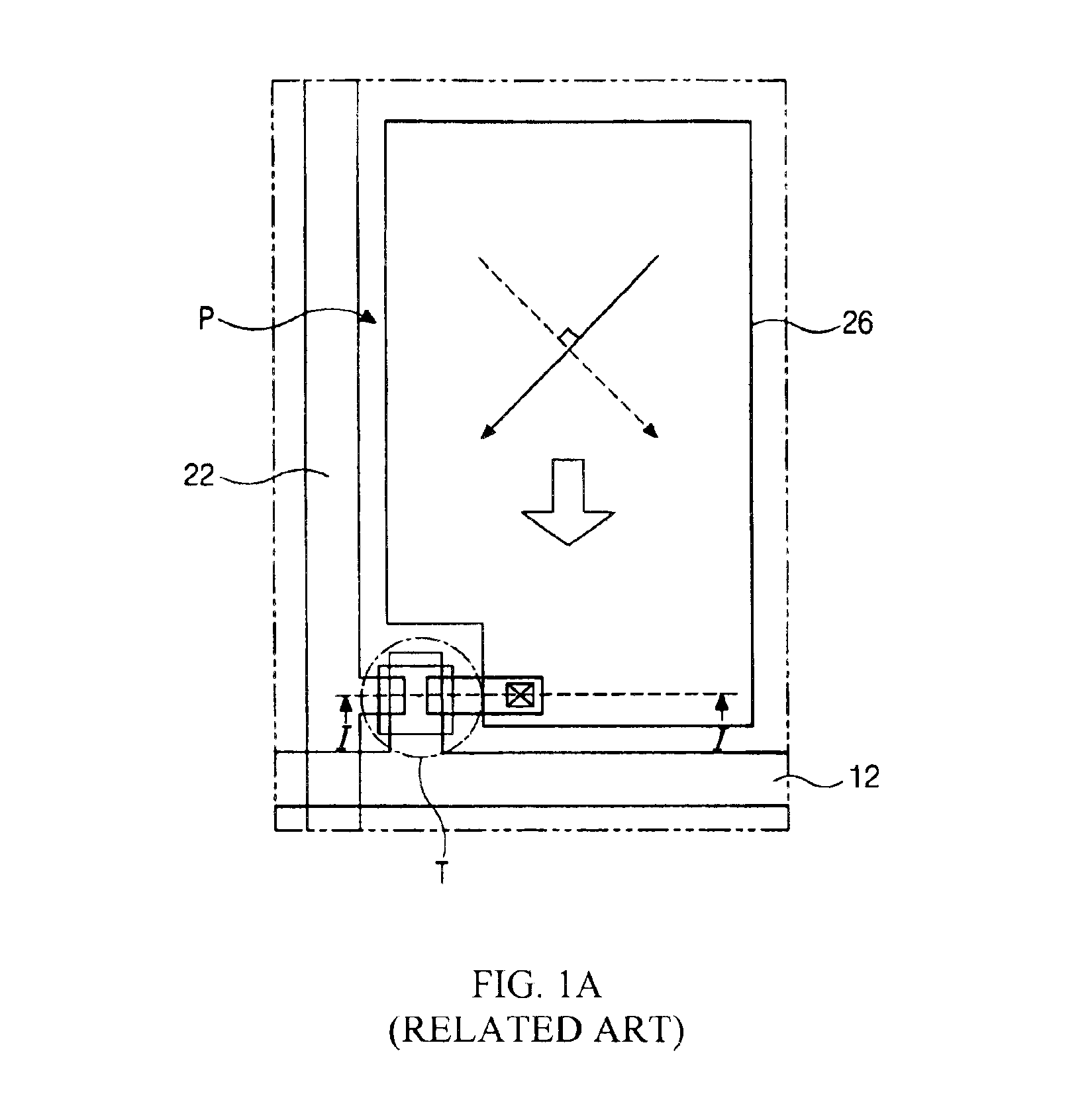Liquid crystal display device and a method of manufacturing a viewing angle compensation film for the same
a liquid crystal display and compensation film technology, applied in the direction of optics, polarising elements, instruments, etc., can solve the problems of defective uneven illumination of liquid crystal display devices, etc., and achieve the effect of improving viewing angle and stable multi-domain structur
- Summary
- Abstract
- Description
- Claims
- Application Information
AI Technical Summary
Benefits of technology
Problems solved by technology
Method used
Image
Examples
first embodiment
FIG. 3 is a plan view of a liquid crystal display (LCD) device having a two-domain structure according to the present invention. In FIG. 3, a gate line 212 is formed in a first direction and a data line 222 is formed in a second direction substantially perpendicular to the first direction. The gate and data lines 212 and 222 define a pixel region “P” by crossing each other. A thin film transistor “T” is formed at a crossing portion of the gate and data lines 212 and 222. A pixel electrode 226 connected to the thin film transistor “T” is formed in the pixel region “P”. In addition, an auxiliary electrode 224 is formed around the pixel electrode 226 in the pixel region “P”. That is, the pixel region “P” may be defined as a region substantially enclosed by the auxiliary electrode 224. The auxiliary electrode 224 is spaced apart from the adjacent gate line 212, the data line 222 and the pixel electrode 226. However, the auxiliary electrode 224 may be partially overlapped with the gate l...
second embodiment
FIG. 5 is a cross-sectional view of a liquid crystal display (LCD) device having a two-domain structure and a compensation film according to the present invention. An explanation about the same elements as those in FIG. 4 will be omitted for convenience of explanation. In FIG. 5, first and second compensation films 210 and 220 are formed respectively on outer surfaces of a liquid crystal display panel 200 having a two-domain structure. The first and second compensation films 210 and 220 respectively have oblique side having a certain angle with respect to a bottom surface of the first and second compensation films 210 and 220, and discotic liquid crystal molecules 215 in the first and second compensation films 210 and 220 are arranged along the oblique sides of the first and second compensation films 210 and 220. As illustrated in FIG. 5, the first and second compensation films 210 and 220, respectively, have a shape of an isosceles triangle and vertices 210a and 220a of the first a...
third embodiment
FIG. 7 is a plan view of a liquid crystal display (LCD) device having a two-domain structure according to the present invention. In FIG. 7, a gate line 412 is formed in a first direction and a data line 422 is formed in a second direction substantially perpendicular to the first direction. The gate and data lines 412 and 422 define a pixel region “P” by crossing each other. A thin film transistor “T” is formed at a crossing portion of the gate and data lines 412 and 422. A pixel electrode 426 connected to the thin film transistor “T” is formed in the pixel region “P”. In addition, an auxiliary electrode 424 is formed around the pixel electrode 426 in the pixel region “P”. That is, the pixel region “P” may be defined as a region substantially enclosed by the auxiliary electrode 424. The auxiliary electrode 424 is spaced apart from the adjacent gate line 412, the data line 422 and the pixel electrode 426. However, the auxiliary electrode 424 may be partially overlapped with the gate l...
PUM
 Login to View More
Login to View More Abstract
Description
Claims
Application Information
 Login to View More
Login to View More - R&D
- Intellectual Property
- Life Sciences
- Materials
- Tech Scout
- Unparalleled Data Quality
- Higher Quality Content
- 60% Fewer Hallucinations
Browse by: Latest US Patents, China's latest patents, Technical Efficacy Thesaurus, Application Domain, Technology Topic, Popular Technical Reports.
© 2025 PatSnap. All rights reserved.Legal|Privacy policy|Modern Slavery Act Transparency Statement|Sitemap|About US| Contact US: help@patsnap.com



